- MOE
- National Parks of Japan
- Akan-Mashu National Park
- Characteristics
main body

Characteristics
A Vast Landscape Comprising Japan's Largest Caldera Landform, Volcanoes, Forests, and Lakes
Date of Designation: December 4, 1934
Area: 91,413 ha
Related Prefecture: Hokkaido
Area: 91,413 ha
Related Prefecture: Hokkaido
Located in the eastern part of Hokkaido, Akan-mashu National Park is one of the longest established parks in Hokkaido. Most of the park area is covered in natural forest comprising mainly subarctic mixed coniferous forest that is said to be some of the most primeval forests of all the national parks in Japan.
The foundation for Akan-mashu National Park comprises three caldera landforms --the Akan Caldera, Kussharo Caldera, and Mashu Caldera --which were formed by the volcanic activity of the Chishima Volcanic Zone. With several volcano-lake pairs in close proximity within a narrow space, the area is nationally valuable.
The park can be broadly divided into two areas: the Akan area and the mashu (Kawayu) area. In the Akan area, the sights to see include Mt. Me-akan and Mt. O-akan which tower sedately over nearby lakes and reservoirs such as Lake Akan and Lake Onneto in a breathtaking landscape. In the mashu (Kawayu) area, the sights to see are Lake Mashu --one of the most transparent lakes in the world --as well as Lake Kussharo, which can be viewed from the surrounding mountain passes and peaks, and the colors of the forests, which transform with the seasons.
The foundation for Akan-mashu National Park comprises three caldera landforms --the Akan Caldera, Kussharo Caldera, and Mashu Caldera --which were formed by the volcanic activity of the Chishima Volcanic Zone. With several volcano-lake pairs in close proximity within a narrow space, the area is nationally valuable.
The park can be broadly divided into two areas: the Akan area and the mashu (Kawayu) area. In the Akan area, the sights to see include Mt. Me-akan and Mt. O-akan which tower sedately over nearby lakes and reservoirs such as Lake Akan and Lake Onneto in a breathtaking landscape. In the mashu (Kawayu) area, the sights to see are Lake Mashu --one of the most transparent lakes in the world --as well as Lake Kussharo, which can be viewed from the surrounding mountain passes and peaks, and the colors of the forests, which transform with the seasons.
Terrain/ Scenery

Akan Caldera
The Akan Area
The Lake Akan Caldera was created between several hundreds of thousands and 150,000 years ago by volcanic activity. The Old Lake Akan, which was created first, was divided approx. 10,000 years ago by the eruptive activity of Mt. O-akan creating today's Lake Akan as well as Lake Panketo and Lake Penketo.
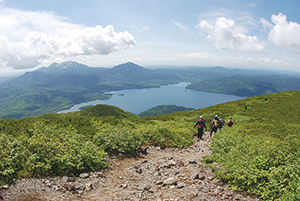
Lake Akan as viewed from Mt. O-akan
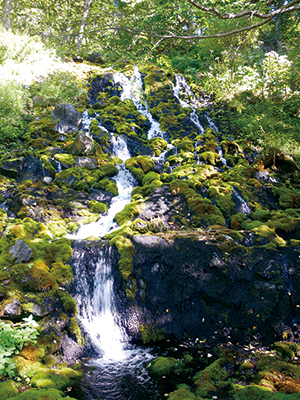
Onneto-yu-no-taki Falls
Today the caldera is surrounded by volcanoes, including Mt. Me-akan (1,499 m above sea level) as well as Mt. O-akan (1,370 m above sea level), Mt. Fuppushi (1,225 m above sea level), and Mt. Kikin (995 m above sea level). These harmonize superbly with the beautiful lakes and reservoirs, such as Lake Akan, Lake Panketo, Lake Penketo, and Lake Onneto, and the subarctic mixed forests of conifers and broad-leaved trees -mainly Yezo spruce and Sakhalin fir -surrounding them, present a majestic northern landscape.
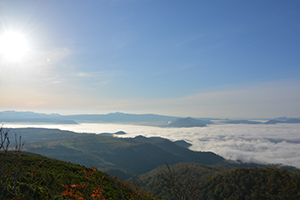
Lake Kussharo (caldera lake)
The Kawayu Area
The original form of the Kussharo Caldera is thought to have been created by a huge volcanic eruption that occurred approx. 130,000-100,000 years ago. This area has many sights to see, including Japan's largest caldera lake, Lake Kussharo (area: approx. 80 km2), which is located inside the caldera; the magnificent somma, which includes Bihoro Pass and Mt. Mokoto (1,000 m above sea level); and Mt. Iwosan (Atosanupur) (508 m above sea level), the foot of which is covered in an expansive colony of Ledum Palustre var. diversipilosum. The area also has many onsen, including the Kawayu Onsen as well as Nibushi Onsen, sand baths, Ike-no-Yu Onsen, and Wakoto Onsen. Furthermore, various phenomena characteristic of very cold regions can also be observed, including the cracks formed in the ice on the surface of Lake Kussharo, diamond dust, frost cracks, soft rime, and air frost.
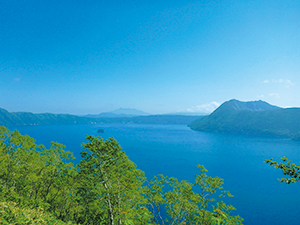
Lake Mashu as viewed from the Lake Mashu Observatory
The Mashu Caldera was formed approx. 7,000 years ago by an enormous volcanic eruption; inside the caldera is Lake Mashu, which boasts one of the highest levels of transparency in the world. Lake Mashu is a lake with no rivers flowing in or out of it; on the southeastern wall of the caldera is Mt. Mashu (Kamuinupuri; 857 m above sea level), which has a huge explosion crater, while on the southwestern side is Mt. Nishibetsu (800 m above sea level), which is a treasure trove of alpine plants. Lake Mashu is also known for the thick fogs that frequently occur there and which, with the deep blue of the lake surface, create a mysterious atmosphere.
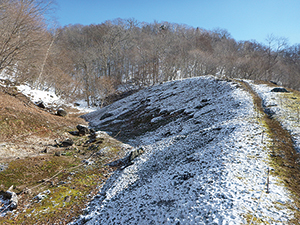
Mt. Ponpon
Hot Springs (Onsen)
There are also hot springs located throughout the park, and unique phenomena such as bokke (bubbling mud pools) around Lake Akan and Mt. Ponpon (cavity phenomenon) near Nibushi can be seen. Also, in areas where geothermal phenomena occur, a unique distribution of organisms and ecology can be observed, such as the Hyalessa maculaticollis living at the northernmost limit of their habitat (Wakoto Peninsula) and crickets that are active even in winter.
Plants
The foundation for Akan-mashu National Park ecosystems are the area's vast forests and richly unique lakes and reservoirs. The forests covering the bases of Mt. Me-akan and Mt. O-akan are mixed forests of conifers and broad-leaved trees comprising mainly Sakhalin fir and Yezo spruce, and well as magnificent pure forests of Picea glehnii.
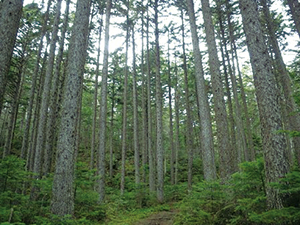
Picea glehnii
Also, pure forests of Erman's birch can be seen in the areas surrounding the Mashu Caldera and Mt. Nishibetsu , and a unique landscape can be seen around Mt. Iwosan, where colonies of dwarf stone pine and Ledum Palustre var. diversipilosum spread across the land, despite the low altitude. Plants whose Japanese names incorporate the word "Akan" include Potentilla miyabei (Meakan Kinbai), Arenaria merckioides var. merckioides (Meakan Fusuma), and Carex loliacea (Akan Suge).
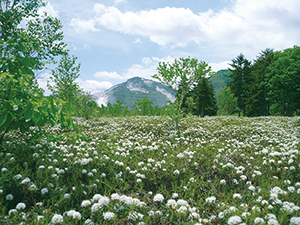
Ledum Palustre var. diversipilosum
In addition, unusual plants called Moss Balls grow in Lake Akan; these fascinating plants have been designated as National Special Natural Monuments.
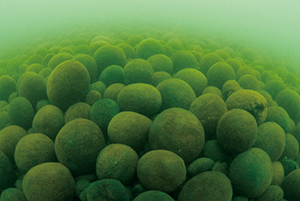
Moss Balls
Wildlife
The forests of Akan are home to Yezo deer, brown bears, Ezo red foxes, raccoon dogs, Japanese sable, and other mammal species.
Bird species that can be frequently observed in the park include small birds such as goldcrests and coal tits that prefer coniferous forests, as well as the black woodpecker and great spotted woodpecker. In addition, large grey herons and various duck species live around each of the lakes and reservoirs.
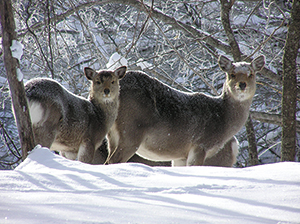
Yezo Deer
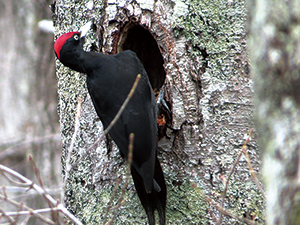
Black Woodpecker
Regarding fish species, Lake Akan is home to white-spotted char and kokanee, while many fish species have been confirmed to live in Lake Kussharo and Hyotan Marsh. However, there is concern over the impact of invasive species such as signal crayfish and tropical fish on the ecosystem.
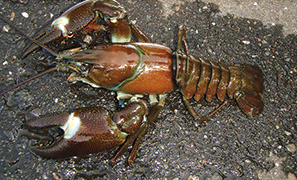
Signal Crayfish (invasive species)
Culture
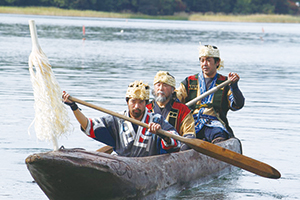
Ainu ethnic costumes and dugout canoe
There are settlements of Ainu People, the indigenous people of Japan, throughout Hokkaido, and one is located on the shore of Lake Akan. Located to the east of the Akanko Onsen, Lake Akan Ainu Kotan comprises approx. 30 households and is the largest settlement of Ainu people in Hokkaido. In addition to rows of folk craft shops, the Ainu theater Ikor presents performances of traditional Ainu dance, which has been designated as a National Important Intangible Cultural Heritage, as well as puppet plays.

Iomante fire festival
The Ainu people have traditionally been a hunting, gathering, and fishing people, and as such, they venerate bears as the manifestation of a high-ranking mountain god who descends from his heavenly kingdom to visit the earth dressed in meat and fur for the benefit of humans. Iomante is a ritual performed by the Ainu people to send the spirit of the mountain god back to his kingdom. In the Iomante Fire Festival, it is possible to see various dances and traditional rituals in a sacred atmosphere, such as the Fire Lighting Ceremony conducted by Ainu elders. Today, performances of the Iomante Fire Festival are presented at the Lake Akan Ainu Theatre Ikor May-June and to enable visitors to September-November experience Ainu culture.
